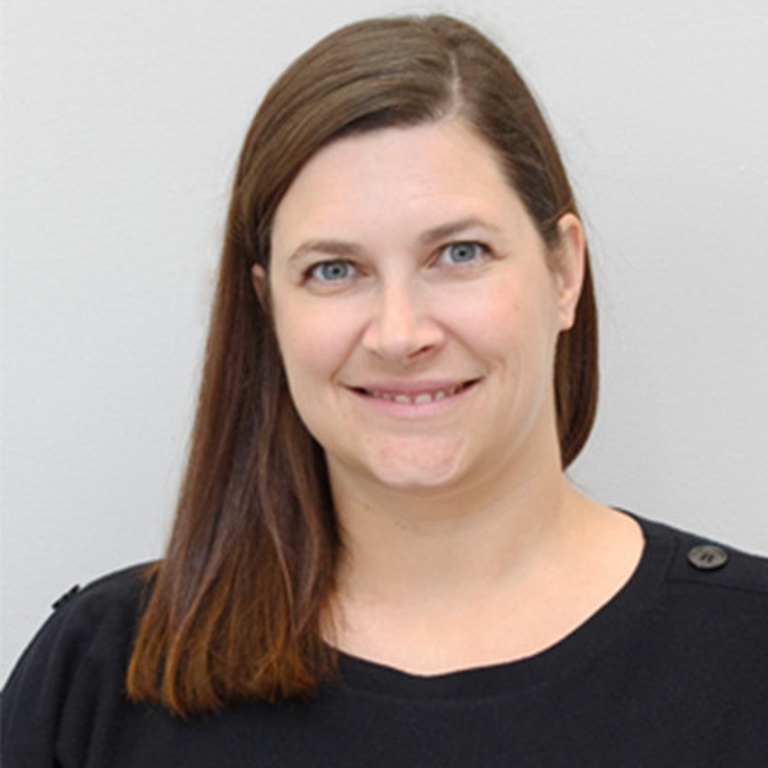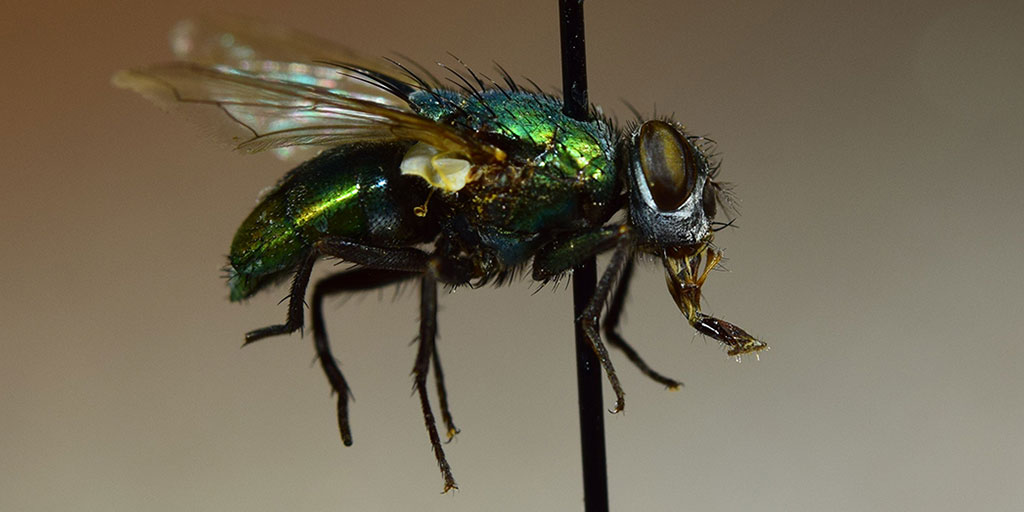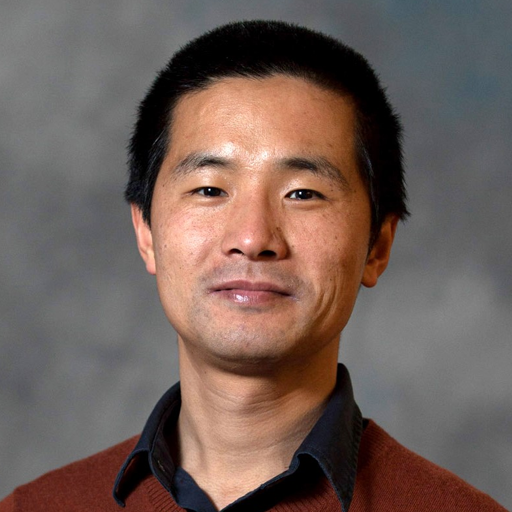Description of the video:
[Upbeat music plays]
[Video] 2020 Research Frontiers Trailblazer Recipients appears in red text against white background
[Video] Woman with crossed arms stands in front of windows, smiling at camera. IU Trident and text Christine Picard, PHD, Associate Professor of Biology appears in lower third of screen
[Picard speaking] So my research looks at investigating the correlation between insects and some of the behaviors
[Video] Picard seated in classroom speaking to camera
[Picard speaking]they exhibit. And so we do that by looking at the DNA level. And we're interested in applying that to a couple of different areas. One area in particular is trying to understand
[Video] Picard and another woman, wearing masks, talk to each other next to shelves in a laboratory
in a forensic context, how quickly or how slowly an insect develops.
[Video] Closeup of insects inside a plexiglass frame
And that can be useful for estimating a post-mortem interval,
[Video] Picard sits in classroom speaking to camera
for example. So it has a big forensic application. Another area that we're interested in is insects as feed and food.
[Video] Picard and another woman wearing lab coats look at computer screen in laboratory
It's a sustainable agricultural
[Video] Closeup of graph on computer screen
product. It is the future
[Video] Closeup of woman wearing mask looking at computer screen in lab
of food, likely,
[Video] Return to Picard sitting in classroom and speaking to camera
and so we are interested in trying to understand how these insects develop and how we can optimize that to make it even better of a system.
[Video] Picard and another woman wearing lab coats and masks work with samples in a laboratory
Every day when I speak with my students, and I hear about new things that they've discovered,
[Video] Closeup of hand wearing blue glove holding test tube in laboratory
it just gives me another boost to just keep going. And so I think that I'm trying to
[Video]Closeup of insects pinned in trays
continue to discover new things and to learn something, which is what I've
[Video] Picard wearing mask and lab coat looking into microscope in a lab, with second woman in mask and lab coat standing nearby
wanted to do all along. I just want to learn something new every day, and I'm lucky that I get to do that.
[Video] Return to Picard sitting in classroom and speaking to camera
Having an impact on society as a whole would be the ultimate goal for any researcher. And, whether it's the forensic science work that I do, which would have an impact on victims and other people associated with
[Video] Picard walks down hall, facing away from camera
the criminal justice system, to the insects as feed and food, which will allow us to feed the growing population in this
[Video] Camera switches to front view of Picard walking down hall, wearing mask, and then entering laboratory
era of climate change. And so I think that's how you gauge success is how that impacts society as a whole.
[Video] Brief fade to black, then image of man with arms crossed appears on screen. IU trident and text Lixin Wang, PHD, associate professor of earth sciences, appears on lower part of screen.
[Wang speaking] My field of research is ecohydrology, and essentially, I'm interested in the interaction between vegetation
[Video] Wang sits in chair, speaking to camera
dynamics and the water cycle. I think I'm always thinking about cutting edge questions in my field in terms of how vegetation impacts the climate, impacts the whole earth's system. Because while it's a big unknown question in the earth-science system, is how vegetation
[Video] Wang and another man, both wearing masks and lab coats, work together in laboratory
actually responds to the climate change and to regulate the climate. So my research
[Video] Close up of Wang, wearing mask
will basically address the fundamental questions, how vegetation plays a role
[Video] Man points to graphs on computer scree
in the whole system, and that will reduce our future predictions about impact of climate change on the whole earth.
[Video] Return to Wang sitting in chair and speaking to camera.
For example, I talk about drought impact for agriculture
[Video] Wang works in laboratory, wearing lab coat and mask
that is by example. Utilizing the knowledge of ecohydrology to helping the societal issue. At the same time, not only agriculture plant will be impacted, so natural plants,
[Video] Close up of man's hand making notes on piece of paper
natural vegetation will also get impacted.
[Video] Return to Wang sitting in chair and speaking to camera.
For example, we have a project that is a forest response to drought. So we know forest is actually a big player in term of the global carbon cycle. Because forest, together with soil, they actually take up
[Video] Wang and another man, both wearing masks and lab coats, work in a laboratory
30% of the global carbon we emit. And when drought comes, that will reduce their capacity to actually take up the CO2.
[Video] Closeup of man's hand putting test tubes with green tops into a tray
At same time we know some trees are different from others. So
[Video] Return to Wang siting in chair and speaking to camera.
basically it's a forest composition will actually impact the carbon sequestration of the whole forest. So my research actually tries to understand how they can do that, why they do that? So we actually use some advanced technique to actually monitor their physiological response and try to understand
[Video] Wang walks down hall toward camera, wearing mask and lab coat, and opens door to enter laboratory.
why they do that. Because I think only if we understand why they do that, we can then understand how do they respond in the future.
[Video] Brief fade to black. Woman appears on screen smiling at camera. IU Trident and text Wendy Miller, PHD, RN, associate professor of community & health systems, appears on lower part of screen.
So my research program is focused on improving self-management and quality of life for people with chronic diseases and
[Video] Miller sits in classroom speaking to camera
specifically epilepsy. And my program of research really focuses on using the patient voice through big data and other methods to make sure that the interventions that we build are really focused on what's important to patients. So capturing the patient voice is really important when you're building a behavioral intervention to improve outcomes. And when I did my
[Video] Miller walks down hall toward camera, carrying a closed laptop. She opens door and enters an office.
PhD and then my early career as a scientist, we relied on traditional methods like qualitative and then quantitative surveys and model testing. But
[Video]: Return to Miller sitting in chair and speaking to camera.
what's really unique about my research now is that we have added to that the mining of social media data. So patients, when they have questions about their illness, not just in epilepsy, but in others, they will join a Facebook group. They will go to a foundation site like the Epilepsy Foundation and ask each other questions.
[Video] Miller looks at computer screens
So when you mind that data, it, the difference between that and the traditional methods is it's an organic type of data generation. There was no
[Video] Close up of woman's hand using computer mouse
instrument through which that data came
[Video] Miller looks at computer screens, nameplate with Wendy R Miller, Phd, appears in foreground
from the participant. So it's actually in some cases more reliable and it doesn't rely on
[Video]Return to Miller sitting in classroom and speaking to camera
the researcher to know what to ask. So I did get some pushback initially because it is so new and sort of a strange way to do this type of research, but it has been extremely successful and shown us things that we didn't know that we're now building into interventions to help people with epilepsy. Even though they have an illness, as a nurse, my perspective is getting them to their maximum level of functioning, even in the context of having that illness. So I think it's all about quality of life. So that is where this type of research can really be impactful. I really didn't know if we would find anything different in social media or other large data sets or
[Video] Miller walks down hallway, facing camera
Twitter. But I feel like here we have the freedom to be as innovative as we possibly can be because that's the only way that we're going to make these large gains.
[Video] Brief fade to black. Bearded man wearing glasses appears on screen. IU Trident and text Jeremy Carter, PHD, director of criminal justice and public safety appears in lower third of screen.
My research put simply involves creating evidence-based strategies for policing
[Video] Carter sits in chair speaking to camera.
and criminal justice more broadly. And most recently I've been involved with doing spatial temporal data modeling. Especially how can we take data in space and time and use it to help anticipate where problems and
[Video] Carters sits at long table working on a laptop
challenges are going to be in our community? So hopefully we can develop effective interventions.
[Video] Closeup of Carter looking at laptop
So they're, evidence-based. When you work with the police department,
[Video] Camera angle over Carter's shoulder as he works on laptop
what you do can impact everyone that lives in that city. But most importantly,
[Video] Return to Carter sitting in chair and speaking to camera
what we're looking for are, are we making an impact in those communities that most need it? And so when we talk about the intersections of service delivery
[Video] Carter works on laptop in front of two desktop computer screens
of access to good quality of life outcomes, when we talk about systematic racism and we talk about social unrest around social issues, all those things coincide in different parts of the city.
[Video] Return to Carter sitting in chair and speaking to camera
And so what we're trying to do is really figure out where in the city can we have the biggest impact on people's lives and that's through using the data
[Video] Carter walks down hallway. Screen changes to white background with IU Trident and the words IUPUI Office of the Vice Chancellor for Research and Filmed at the IUPUI Faculty Crossing appear on the screen
on those metrics to inform what we do in our field.
[Video] Music plays, fades out.






